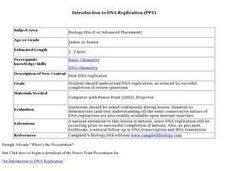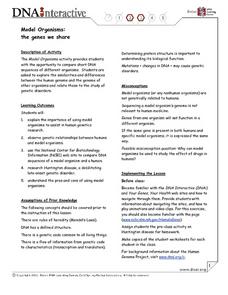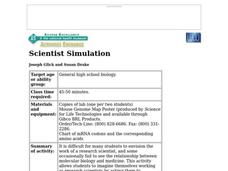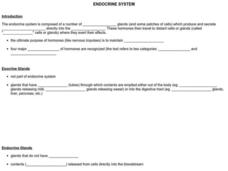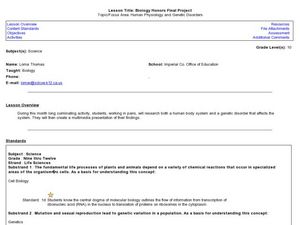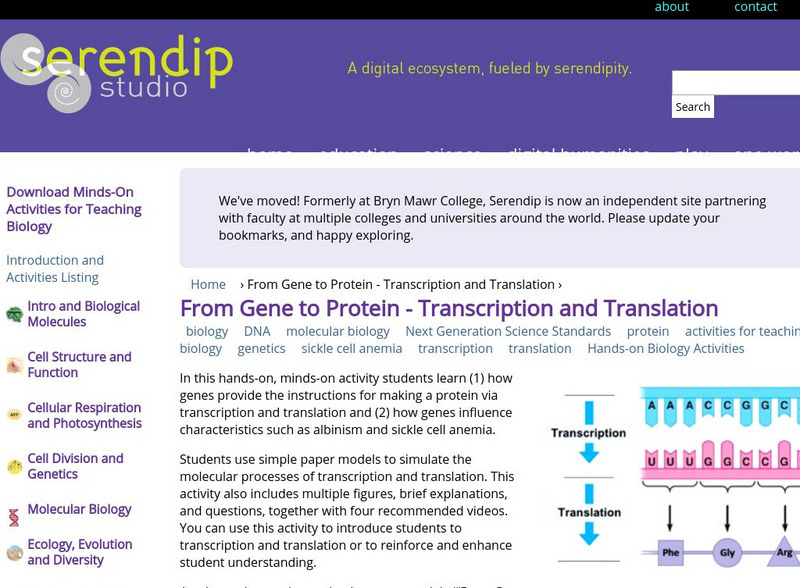Curated OER
Scientist Simulation
Students envision the work of a research scientist, and the relationship between molecular biology and medicine. This activity allows students to imagine themselves working as research scientists by asking them to complete the end-steps...
Curated OER
Introduction to DNA Replication
Students discover how DNA replicates through a PowerPoint lecture. Lesson includes a link to download entire PowerPoint lesson. Student understanding is evaluated with review questions.
Curated OER
Cells Study Questions and Definition
For this cells worksheet, students define 14 words associated with cells. They answer 12 short answer questions about the structure and function of the cellular system.
Curated OER
Model Organisms: The Genes We Share
Young scholars gather information about gene banks. In this biology lesson, students work in groups to complete an activity sheet about genetic databases and organism genomes. Lesson includes extension ideas.
Curated OER
Physical vs. Chemical
In this physical vs. chemical change activity, students answer 10 questions about identifying chemical and physical changes. They identify exothermic and endothermic reactions and the parts of a chemical equation. Students answer 1...
Curated OER
How Genes Work Lesson Plan
Students define the key terms that are the structure and function of DNA. In this genetics lesson plan students complete a lab activity in which they construct a model DNA structure.
Curated OER
Upper and Lower Case Alphabet Cards: Black Background, White Letters
For this alphabet cards worksheet, students cut apart 52 alphabet cards; an upper and lower case Zaner-Bloser letter example for each of the 26 letters. The cards have a decorative border and a black background with white letters. There...
Curated OER
The Meaning of Genetic Variation
Students investigate variation in the beta globin gene by identifying base changes that do and do not alter function, and by using several Internet-based resources to consider the significance in different environments of the base...
Curated OER
The Electrophoresis of Human Hemoglobin
Young scholars analyze different types of hemoglobin. They use the technique of agarose gel electrophoresis to separate human hemoglobin molecules according to their electrical charge, size, and/or shape. Students relate the migration...
Curated OER
"Chips" Off the Old Block?
Students study using analogies between common items or occurrences and science concepts. They use the analogy of cookie recipes to that of the DNA "recipes" for living things to help us explain more about mutations.
Curated OER
Scientist Simulation
Students imagine themselves working as research scientists completing the end-steps of a molecular research project and interpreting the data. They compare the gene sequences of normal and abnormal mice and evaluate the protein product...
Curated OER
Endocrine System
In this endocrine system activity, students compare and contrast the glands associated with this body system plus review the four major classes of hormones. This activity has 25 fill in the blank statements.
Curated OER
Biology Honors Final Project
Tenth graders work on a project about cellular biology and genetics. In this biology instructional activity, 10th graders research about the assigned human body system and genetic disorders that affect it. They create a multimedia...
Cold Spring Harbor Laboratory
Dolan Dna Learning Center: Transcription Translation: Transcription Advanced
Visualize the main driving force behind molecular biology, where DNA makes RNA, and RNA makes protein. [1:53]
Cold Spring Harbor Laboratory
Dolan Dna Learning Center: Transcription Translation: Central Dogma of Biology
This animation shows how the DNA genetic code leads to proteins that help us develop and function. [2:51]
Cold Spring Harbor Laboratory
Dolan Dna Learning Center: Transcription & Translation: Transcription Basic
A brief animation showing the basics of DNA transcription in cells. [1:52]
Cold Spring Harbor Laboratory
Dolan Dna Learning Center: Transcription & Translation: Translation
This animation demonstrates the process of RNA translation that ultimately results in a new protein. [2:04]
Bryn Mawr College
Serendip: From Gene to Protein Transcription and Translation
Brief text summary of what young scholars learn in the Dragon Genetics II lab along with links to download Student Handouts in PDF and Word formats, and Teacher Preparation Notes in PDF format. Students use paper models to learn...
Cold Spring Harbor Laboratory
Dna Learning Center: Transcription & Translation: M Rna Splicing
Once a gene has been located and transcribed into mRNA, it must first be edited before it can be translated into a protein. This editing process is called splicing it involves removing non-coding regions called "introns", leaving only...
Cold Spring Harbor Laboratory
Dolan Dna Learning Center: Transcription & Translation: Translation Advanced
Dig a little deeper into the intricate role of RNA in DNA translation during the process of protein synthesis. [3:03]
Khan Academy
Khan Academy: Regulation After Transcription
Learn the importance of alternative splicing, miRNAs, and siRNAs, translation initiation factors, and protein modifications during the process of protein synthesis.
CK-12 Foundation
Ck 12: Biology: Protein Synthesis Study Guide
This study guide on protein synthesis covers key terminology, protein molecules and the genetic code, RNA types and their roles, transcription, translation, and a few misconceptions. It is available for download with free registration.
Estrella Mountain Community College
Estrella Mountain Community College: Translation
For the section including translation, go to "the genetic code" chapter in the table of contents. This explanation includes diagrams and illustrations as well as a codon code table.
Education Development Center
Education Development Center: How Does Dna Work?
Learning about transcription and translation can be difficult but this animation helps make the processes less confusing. The animation is interactive and it also covers the overall importance of proteins.



